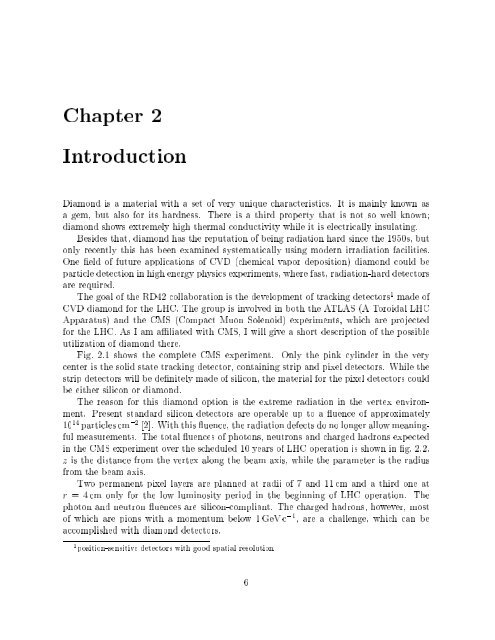Diamond Detectors for Ionizing Radiation - HEPHY
Diamond Detectors for Ionizing Radiation - HEPHY
Diamond Detectors for Ionizing Radiation - HEPHY
Create successful ePaper yourself
Turn your PDF publications into a flip-book with our unique Google optimized e-Paper software.
Chapter 2<br />
Introduction<br />
<strong>Diamond</strong> is a material with a set of very unique characteristics. It is mainly known as<br />
a gem, but also <strong>for</strong> its hardness. There is a third property that is not so well known;<br />
diamond shows extremely high thermal conductivity while it is electrically insulating.<br />
Besides that, diamond has the reputation of being radiation hard since the 1950s, but<br />
only recently this has been examined systematically using modern irradiation facilities.<br />
One eld of future applications of CVD (chemical vapor deposition) diamond could be<br />
particle detection in high energy physics experiments, where fast, radiation-hard detectors<br />
are required.<br />
The goal of the RD42 collaboration is the development of tracking detectors 1 made of<br />
CVD diamond <strong>for</strong> the LHC. The group is involved in both the ATLAS (A Toroidal LHC<br />
Apparatus) and the CMS (Compact Muon Solenoid) experiments, which are projected<br />
<strong>for</strong> the LHC. As I am aliated with CMS, I will give a short description of the possible<br />
utilization of diamond there.<br />
Fig. 2.1 shows the complete CMS experiment. Only the pink cylinder in the very<br />
center is the solid state tracking detector, containing strip and pixel detectors. While the<br />
strip detectors will be denitely made of silicon, the material <strong>for</strong> the pixel detectors could<br />
be either silicon or diamond.<br />
The reason <strong>for</strong> this diamond option is the extreme radiation in the vertex environment.<br />
Present standard silicon detectors are operable up to a uence of approximately<br />
10 14 particles cm ,2 [2]. With this uence, the radiation defects do no longer allow meaningful<br />
measurements. The total uences of photons, neutrons and charged hadrons expected<br />
in the CMS experiment over the scheduled 10 years of LHC operation is shown in g. 2.2.<br />
z is the distance from the vertex along the beam axis, while the parameter is the radius<br />
from the beam axis.<br />
Two permanent pixel layers are planned at radii of 7 and 11 cm and a third one at<br />
r = 4cm only <strong>for</strong> the low luminosity period in the beginning of LHC operation. The<br />
photon and neutron uences are silicon-compliant. The charged hadrons, however, most<br />
of which are pions with a momentum below 1 GeV c ,1 , are a challenge, which can be<br />
accomplished with diamond detectors.<br />
1 position-sensitive detectors with good spatial resolution<br />
6












